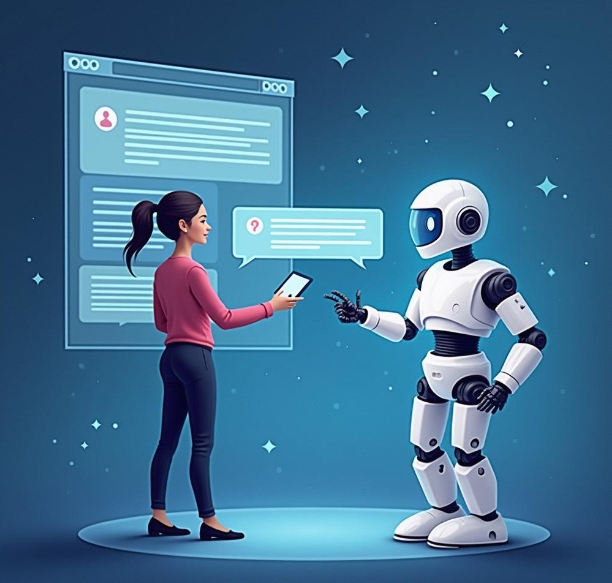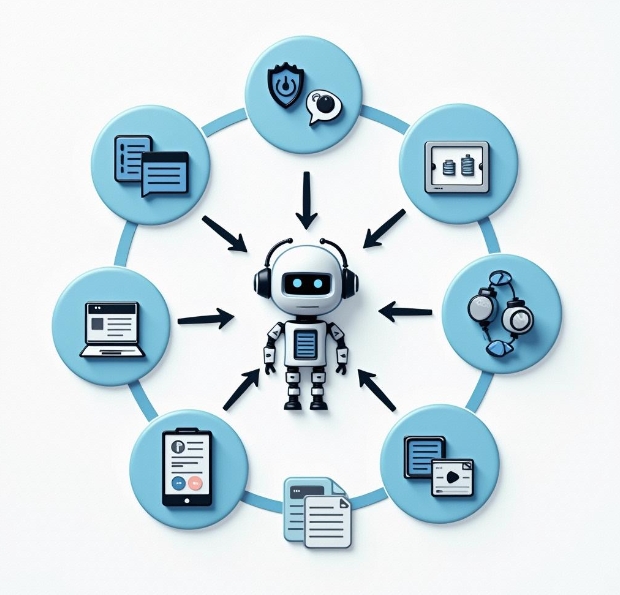Enterprise AI Chatbot Development: The Technological Engine Driving Intelligent Transformation
- latest articles
- 1.DApp Development & Customization: Merging Diverse Market Needs with User Experience 2.Analysis of the Core Technical System in DApp Project Development 3.How to achieve cross-chain interoperability in Web3 projects? 4.How does the tokenization of points reconstruct the e-commerce ecosystem? 5.How to Set and Track Data Metrics for a Points Mall? 6.What is DApp Development? Core Concepts and Technical Analysis 7.Inventory of commonly used Web3 development tools and usage tips 8.Development of a Distribution System Integrated with Social E-commerce 9.Six Key Steps for Businesses to Build a Points Mall System 10.What is DApp Development? A Comprehensive Guide from Concept to Implementation
- Popular Articles
- 1.Future Trends and Technology Predictions for APP Development in 2025 2.Analysis of the DeFi Ecosystem: How Developers Can Participate in Decentralized Finance Innovation 3.From Zero to One: How PI Mall Revolutionizes the Traditional E-commerce Model 4.DAPP Development | Best Practices for Professional Customization and Rapid Launch 5.Recommended by the Web3 developer community: the most noteworthy forums and resources 6.From Cloud Computing to Computing Power Leasing: Building a Flexible and Scalable Computing Resource Platform 7.How to Develop a Successful Douyin Mini Program: Technical Architecture and Best Practices 8.Shared Bike System APP: The Convenient Choice in the Era of Smart Travel 9.How to Create a Successful Dating App: From Needs Analysis to User Experience Design 10.From Design to Development: The Complete Process of Bringing an APP Idea to Life
Driven by the wave of digitalization and intelligence, enterprises are facing pressure to transform and upgrade. How to leverage the latest technologies to enhance operational efficiency, service quality, and customer experience has become a core issue in business development. As a cutting-edge technology, Artificial Intelligence (AI) chatbots are emerging as a key driver of enterprise intelligent transformation. Through automated interactions with customers, chatbots can help businesses improve response speed, reduce costs, and enhance customer satisfaction. This article will delve into the applications of AI chatbots and their significant role in promoting enterprise intelligent transformation.
I. Overview of AI Chatbots
AI chatbots typically refer to program systems based on artificial intelligence technology that can simulate conversations with human users. They can understand natural language and provide corresponding responses and interactions based on predefined rules or learned knowledge. With advancements in deep learning and Natural Language Processing (NLP) technologies, AI chatbots are no longer just simple Q&A tools but possess capabilities such as sentiment analysis, contextual understanding, and handling complex tasks.
In enterprises, AI chatbots are not limited to customer service but can also extend to various business areas such as marketing, sales, data analysis, and internal collaboration. Through real-time interactions with customers, chatbots not only provide 24/7 service but also collect and analyze customer feedback, offering data support for business decision-making.
II. The Role of AI Chatbots in Driving Enterprise Intelligent Transformation
1. Enhancing Customer Service Efficiency and Quality
Traditional customer service methods, which rely on human agents, often suffer from slow response times and inconsistent service quality. AI chatbots, available 24/7, can respond to customer needs in real time, providing fast and efficient service. For example, when customers ask common questions on a website, chatbots can provide accurate answers immediately without waiting for human intervention.
Additionally, through continuous learning and optimization, chatbots can continually improve their service quality. Leveraging natural language processing technology, chatbots can recognize different customers' language habits and provide contextually appropriate responses. For more complex issues, chatbots can engage in multi-turn dialogues to gradually resolve them, significantly enhancing the intelligence level of the service.
2. Reducing Enterprise Operational Costs
In daily operations, the personnel, training, and management costs of human customer service agents represent significant expenses. The introduction of AI chatbots can effectively reduce these costs. Firstly, chatbots can handle a large volume of basic, repetitive tasks, such as checking order status and answering frequently asked questions, alleviating the workload of human agents. Secondly, the deployment and maintenance costs of chatbots are relatively low, and as the technology matures, the operational efficiency and cost-effectiveness of the system will further improve.
For small businesses or startups, AI chatbots offer a low-cost, efficient customer service solution, enabling them to compete with larger enterprises and gain an advantage in customer experience.
3. Data Collection and Analysis for Precision Marketing
AI chatbots are not just service tools; they can also act as data analysts for enterprises. Through every interaction with customers, chatbots can automatically record and analyze customer needs, behaviors, and preferences. This data is crucial for marketing and product development.
For example, based on customer feedback collected by chatbots, businesses can accurately identify market trends, predict changes in customer demand, and adjust marketing strategies and product offerings accordingly. Through detailed customer analysis, enterprises can also achieve personalized product recommendations and customized services, further enhancing customer loyalty and satisfaction.
4. Optimizing Employee Work Efficiency
Within enterprises, AI chatbots can not only improve customer service efficiency but also help optimize employee productivity. For instance, employees can interact with chatbots to access various internal company information, such as attendance, leave, and salary details. Moreover, chatbots can quickly search and provide relevant materials, saving employees time on information retrieval and allowing them to focus on more valuable tasks.
Additionally, AI chatbots can assist in knowledge management. By analyzing daily employee queries, chatbots can summarize common questions and convert this knowledge into a corporate knowledge base. This reduces the training costs for new employees and significantly improves the overall operational efficiency of the enterprise.

III. Development Trends of AI Chatbots
With continuous technological advancements, the functions and application scenarios of AI chatbots are constantly expanding. In the future, chatbots will develop in the following directions:
1. Further Breakthroughs in Natural Language Processing Technology
Currently, AI chatbots have made significant progress in natural language processing, but there are still shortcomings, such as imprecise understanding of polysemous words, dialects, and context. In the future, with advancements in deep learning and semantic understanding technologies, chatbots will be better able to understand and process complex language expressions, improving the quality of interactions with users.
2. Cross-Platform, Multi-Channel Intelligent Interaction
With the popularity of social media and mobile internet, the ways customers interact with enterprises have become more diverse. In the future, AI chatbots will no longer be limited to a single platform or channel but will seamlessly integrate across different platforms (such as websites, social media, instant messaging tools, etc.). Regardless of the platform, users will receive a consistent service experience when interacting with the enterprise.
3. More Intelligent Sentiment Analysis and Personalized Services
Future AI chatbots will possess stronger sentiment analysis capabilities, enabling them to accurately recognize and respond to customers' emotions based on tone, emotional state, and other information. This will make chatbot services more human-like, enhancing customer engagement and satisfaction. At the same time, chatbots will be able to provide personalized recommendations based on customers' historical data, offering tailored services.

IV. Challenges and Responses for Enterprises Implementing AI Chatbots
Although AI chatbots offer numerous benefits, enterprises still face some challenges in practical application:
1. Data Privacy and Security Issues
When interacting with customers, AI chatbots need to process a large amount of personal and sensitive data. Therefore, enterprises must ensure the security of their chatbot systems to prevent data leaks and misuse. This requires not only technical encryption protection but also strict legal and compliance controls.
2. Technology Integration and System Compatibility
When implementing AI chatbots, enterprises often need to integrate them with existing enterprise management systems, CRM systems, etc. This requires a certain level of technical capability and ensuring system compatibility. Otherwise, information silos may occur, hindering data flow and affecting overall efficiency.
3. User Acceptance and Trust Issues
Although AI chatbots perform well in many areas, some users remain skeptical about robot services, worrying that chatbots cannot provide the same level of care and service quality as human agents. To address this, enterprises can offer hybrid service models, allowing users to transfer to human agents when encountering complex issues, thereby improving user trust.
Conclusion
As a key technological engine for enterprise intelligent transformation, AI chatbots have already played a significant role in improving efficiency, reducing costs, and optimizing customer experience. With continuous technological advancements, AI chatbots will be widely applied in more industries and scenarios, becoming a critical force driving enterprises toward intelligent development. However, when implementing this technology, enterprises must also carefully address issues such as data security, technology integration, and user trust. Through continuous improvement and optimization, AI chatbots are expected to bring greater competitive advantages to enterprises in the future.
-

How does artificial intelligence technology transform the operational models of modern enterprises?
In the wave of the digital era, artificial intelligence (AI) technology has tran···
-

How to Utilize Artificial Intelligence for Precision Medicine and Health Management
With the rapid advancement of technology, artificial intelligence (AI) has demon···
-

Integration and Application of Artificial Intelligence and Robotics
In today's era of rapid technological advancement, the integration of artificial···

 Blockchain
Blockchain










